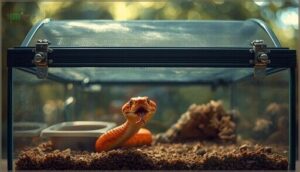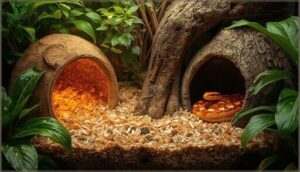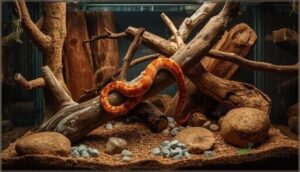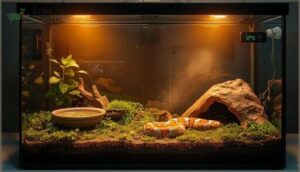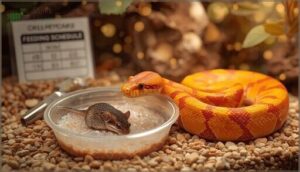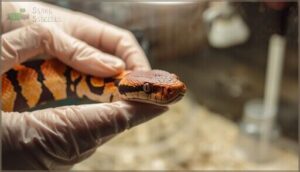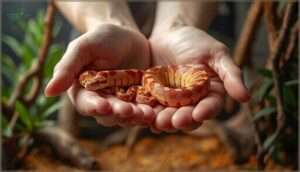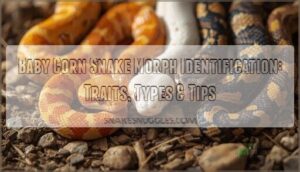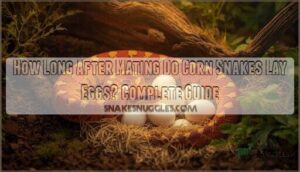This site is supported by our readers. We may earn a commission, at no cost to you, if you purchase through links.
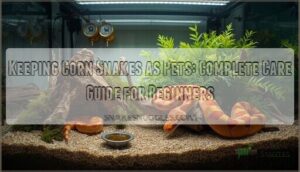
Corn snakes have earned their reputation as the ideal first snake for good reason. These docile reptiles rarely bite, tolerate handling well, and adapt to captive environments with minimal fuss. Unlike ball pythons that often refuse meals or require precise humidity levels, corn snakes eat consistently and forgive minor care mistakes. Their moderate size, topping out around four to five feet, means you won’t need a room-sized enclosure.
Yet keeping corn snakes as pets successfully still demands proper knowledge. The difference between a thriving snake and one plagued by respiratory infections or shedding problems often comes down to understanding their specific needs. From selecting a healthy individual to maintaining the right temperature gradient, each aspect of care builds on the next to create an environment where your corn snake can flourish for its twenty-year lifespan.
Table Of Contents
Key Takeaways
- Corn snakes succeed as beginner pets because they tolerate handling mistakes, eat consistently without fussy requirements, and stay manageable at four to five feet—unlike ball pythons that refuse meals or need precise humidity control.
- Your snake’s enclosure must include a temperature gradient between 75°F and 90°F, humidity levels of 40-60%, secure lids with metal clips to prevent the 46% escape attempt rate, and at least two hiding spots placed on warm and cool sides.
- Frozen mice prevent the 9% injury rate from live prey, juveniles need feeding every five to seven days while adults wait two to three weeks, and you should never handle your snake for 48 hours after meals to avoid regurgitation.
- Health problems like respiratory infections, shedding issues, and mouth rot show up through warning signs such as wheezing, retained skin, or mouth inflammation—catching these early through weekly enclosure cleaning and annual vet exams prevents serious complications.
Choosing The Right Corn Snake
Starting with the right corn snake makes all the difference in your experience as a keeper. You’ll want to focus on three key areas when choosing your new pet: the snake’s overall health, the color and pattern variations available, and what to expect from their natural temperament.
Let’s walk through each of these considerations so you can make an informed decision.
Selecting Healthy Individuals
When choosing a corn snake, start with eye clarity—clear, bright eyes signal good health. Check the skin for smoothness, without wounds or stuck shed. A well-rounded body weight, not overly thin or bloated, matters greatly. Examine droppings for normal consistency.
Always purchase from breeders with strong reputations who prioritize corn snake health and welfare, reducing risks of snake diseases and future veterinary care needs.
A proper vivarium should have good ventilation practices to prevent bacterial buildup.
Popular Color Morphs and Patterns
After confirming your corn snake’s health, you’ll encounter a rainbow of color morphs and patterns in the pet snake ownership world. Over 800 distinct variations exist, though only 28 foundational genetic strains are formally recognized. Morph identification greatly affects market value:
- Classic “Normal” morphs cost $40–$70, ideal for beginners learning corn snake care guide basics
- Rare Palmetto females exceed $550 due to breeding challenges
- Striped and Motley patterns show predictable genetic inheritance
- Piebald varieties like Bloodred Pied Sided command $250–300
Rarest morphs require specialized knowledge beyond basic corn snake characteristics. These variations arise from combinations of wild-type genetic strains.
Understanding Corn Snake Temperament
Beyond color morphs, your corn snake’s behavioral traits matter more than appearance. Over 92% of captive corn snakes display docile temperaments, with fewer than 3% showing defensive responses—making handling acclimation straightforward.
Recognize stress signals like rapid burrowing or freezing, which drop 57% when you provide proper hiding spots. Their solitary nature means housing alone reduces aggression by 43%.
Corn snake behavior adapts well to routine handling schedules, especially during evening hours when they’re naturally active.
Setting Up a Corn Snake Enclosure
Your corn snake’s enclosure functions as its entire world, so getting the setup right from the start matters more than you might think. The right tank size, secure lid, hiding spots, and climbing opportunities all work together to keep your snake healthy and stress-free.
Here’s what you need to know about creating a safe, comfortable home for your new pet.
Recommended Tank Sizes by Age
Your corn snake enclosure needs change as it grows. Hatchling corn snakes thrive in 10-gallon tanks, while juvenile upgrades to a 20-gallon long glass tank work well for snakes up to 3 feet. Subadult tanks should be around 30 gallons, and adult dimensions require at least a 40-gallon enclosure.
Enclosure size directly impacts your snake’s comfort and enrichment needs throughout its life.
Secure Lids and Escape Prevention
According to ownership surveys, corn snakes attempt to escape in nearly 46% of home settings, making secure lids absolutely essential. You’ll need a screened mesh lid with at least four heavy-duty metal clips—one per corner—to prevent your snake from pushing through.
Enclosures with insecure lids account for over 70% of documented escape incidents, so weekly inspection of your lock function and lid fit is critical for keeping your escape artist safely contained.
Substrate and Hiding Places
When setting up your enclosure, you’ll need three to four inches of substrate to support natural burrowing behavior. Aspen shavings, coconut fiber, or DIY bioactive substrates work best because they maintain 65-75% humidity while preventing respiratory issues.
Place at least two snug hide boxes—one on the warm side, one on the cool side—using cork bark or naturalistic hideout box materials for maximum stress reduction.
Climbing Branches and Enrichment
While climbing branches might seem decorative, they transform your corn snake’s tank into a lively environment that directly benefits behavior and wellbeing. Research shows environmental enrichment considerably boosts physical activity and cognitive benefits.
Include these enrichment essentials:
- Three sturdy climbing branches using PVC, hardwood, or cork bark—2-4 cm diameter for safe gripping
- Multiple height variations to encourage behavioral diversity and natural exploration patterns
- Cork flats and rocks to amplify both vertical and horizontal movement options
- Sterilized natural wood replaced every 3-6 months for proper enrichment maintenance
Enriched snakes display increased confidence, problem-solving skills, and 25% more active behaviors than those in barren setups.
Creating The Ideal Habitat Environment
Getting the enclosure set up is just the first step—your corn snake also needs the right environmental conditions to stay healthy and comfortable. Temperature, humidity, and lighting all play important roles in creating a habitat that fosters your snake’s natural behaviors and biological needs.
Let’s break down each element so you can dial in the perfect environment for your new pet.
Temperature Gradients and Regulation
Your corn snake needs a proper thermal gradient to thrive—a warm basking spot at 85°F to 90°F and a cooler zone between 75°F and 82°F. This temperature regulation allows natural basking behavior and efficient digestion. Night temperatures should drop to 65°F–72°F for adults.
Without correct temperature ranges and reliable heat sources, you’ll see shedding issues, feeding refusal, and poor growth in your pet.
Humidity Control and Monitoring
Humidity levels between 40% and 60% keep your corn snake healthy, rising to 70% during shedding. Use a digital thermometer with hygrometer to track these readings accurately.
Substrate choice matters—coconut husk and cypress mulch hold moisture better than aspen. Daily misting and a spacious water dish help maintain proper humidity control.
Add humidity hides filled with damp sphagnum moss to prevent shedding issues and dehydration.
Lighting Needs for Corn Snakes
Your corn snake lighting requirements include a consistent 12-hour light and dark cycle to support healthy circadian rhythms.
UVB importance can’t be overstated—a 6% to 12% T5 HO bulb placed 9 to 12 inches above the basking surface allows vitamin D3 synthesis for calcium metabolism. Pair this with full spectrum daylight bulbs for photoperiod management.
Skip nighttime lighting entirely, as red or blue heat lamp options disrupt sleep and stress your snake.
Feeding and Nutrition Guidelines
Feeding your corn snake the right food at the right time keeps it healthy and thriving. You’ll need to understand what prey to offer, how often to feed based on age, and some basic safety practices.
Let’s break down the essentials of corn snake nutrition so you can feed with confidence.
Appropriate Prey Types and Sizes
Your corn snake diet should center on frozen mice, which deliver the highest nutritional value and prevent obesity risks common with live feeding. Match prey size to your snake’s mid-body width—pinkie mice for hatchlings, progressing to adult mice as they grow.
While wild diet includes birds occasionally, rodents provide better food and water content. Following proper feeding guidelines ensures your snake thrives without digestive issues.
Feeding Schedules for Juveniles and Adults
Once you’ve picked the right prey size, timing matters just as much. Young snakes measuring under twenty inches need meals every five to seven days to fuel rapid growth. Adults over thirty-five inches can wait fourteen to twenty-one days between feedings.
Monitor your snake’s weight monthly and watch for regurgitation signs—these tell you if your feeding schedule needs adjustment.
During winter brumation, many corn snakes naturally eat less, so don’t worry if appetite drops.
Safe Feeding Practices
Feeding frequency sets the stage, but safety determines success. Frozen rodents prevent injuries that live prey inflict—bites occur in nearly 9% of live feedings. Proper prey thawing eliminates bacterial risks: refrigerate for twenty-four hours, then warm in water before offering.
Follow these hygiene protocols religiously:
- Sanitize feeding equipment after every meal to prevent salmonellosis transmission.
- Wait forty-eight hours post-feeding before handling to avoid regurgitation risks.
- Remove uneaten prey within one hour to prevent stress.
- Maintain basking temperatures between 85-90°F during digestion.
Your corn snake diet depends on consistency and cleanliness.
Maintaining Corn Snake Health
Keeping your corn snake healthy means knowing what to watch for and taking simple steps to prevent problems before they start. Most health issues are preventable with proper habitat care and attention to your snake’s behavior.
Let’s cover the signs of common health problems, how to maintain a clean enclosure, and when it’s time to seek professional help.
Common Health Issues and Signs
Your corn snake’s health depends on recognizing warning signs early. Respiratory infections, which can affect up to 30% of cases, cause open-mouth breathing and wheezing. Additionally, watch for parasitic infestations, shedding problems, oral infections, and gastrointestinal issues. A snake’s health can deteriorate quickly without attention, so contact a veterinarian if you notice any of the following symptoms: nasal discharge, retained skin, mouth inflammation, regurgitation, or appetite loss. These are common corn snake health problems that require immediate care.
| Health Problem | Key Warning Signs |
|---|---|
| Respiratory Issues | Wheezing, mucus, open-mouth breathing |
| Parasitic Infestations | Weight loss, diarrhea, skin irritation |
| Shedding Problems | Retained eye caps, incomplete skin removal |
| Oral Infections | Gum bleeding, thick pus, sour odor |
| Gastrointestinal Issues | Regurgitation, constipation, appetite loss |
Preventive Care and Enclosure Cleaning
Regular maintenance is essential to keep your snake healthy and prevent infections. You’ll need to spot clean waste immediately, replace substrate every 3-4 months, and deep clean the entire enclosure every 4-6 weeks using a 3% bleach solution or reptile-safe cleaner.
Water bowls require daily refills and weekly disinfection protocols. These hygiene practices directly reduce health concerns like respiratory infections and parasites.
When to Consult a Reptile Veterinarian
Knowing when your snake needs professional help can prevent serious health concerns. Watch for these illness indicators that require a reptile veterinarian’s expertise:
- Respiratory issues like wheezing or open-mouth breathing, which signal infection
- Mouth rot causing inflammation, bubbles, or discharge in the oral cavity
- Shedding problems lasting over nine days, including retained eye caps
Behavioral changes, fungal infection signs, and zoonotic risks like persistent odor also warrant immediate attention. Annual exams help catch disease early.
Handling and Daily Care Tips
Handling your corn snake properly keeps both you and your pet safe and comfortable. Daily care goes beyond feeding and cleaning—it includes knowing when to interact with your snake and when to leave it alone.
Following a few straightforward practices will help you maintain a healthy routine and prevent common problems.
Safe Handling Techniques
Handling your corn snake correctly transforms a routine interaction into a trust-building experience. Always provide full body support, letting your pet glide across your palms rather than gripping tightly. Slow movements and calm approaches reduce defensive reactions, while frequent but brief sessions—around 10–20 minutes several times weekly—help your snake grow comfortable with you. Proper support techniques and consistent handling frequency strengthen the bond between you and your pet.
| Technique | Why It Matters |
|---|---|
| Full body support | Prevents injury and stress |
| Slow, calm movements | Reduces defensive responses |
| Short, regular sessions | Builds trust over time |
Watch your corn snake’s body language closely. Relaxed tongue flicking and loose coiling signal comfort, while rapid flicking, tight coils, or hissing mean it’s time to pause. Snake hooks can ease initial interactions, especially with nervous individuals.
Hygiene practices matter too—wash your hands before and after every session to protect both you and your snake. These preventative measures keep pet snakes healthy and make corn snake behavior easier to read. Understanding corn snake handling isn’t just about technique; it’s about respecting your pet’s needs and building a lasting connection through consistent, thoughtful snake care and enrichment.
Proper hygiene and consistent handling build trust with your corn snake while preventing disease and making their behavior easier to read
Minimizing Stress During Shedding
Your corn snake’s shedding cycle demands adjustments that reduce stress and support complete skin removal. Boost humidity to 50–60% and add humid hides with damp sphagnum moss on the warm side. Stop handling during the blue phase—defensive behaviors spike above 80%.
Include rough branches for rubbing; they help complete sheds in 84% of cases. Appetite often drops, but that’s normal and temporary.
Hygiene Practices and Disease Prevention
Protecting your snake from illness starts with simple routines that break the chain of contamination. Hand hygiene before and after contact reduces pathogen spread, while enclosure cleaning with 3% bleach solutions weekly keeps disease risks low.
Follow these preventive husbandry essentials:
- Waste Management – Spot-clean daily and replace substrate monthly
- Disinfection Protocol – Apply bleach for 10 minutes, rinse thoroughly
- Health Monitoring – Schedule veterinary care every 6-12 months for early detection
Frequently Asked Questions (FAQs)
Can corn snakes be housed together safely?
You shouldn’t house corn snakes together. Cohabitation risks include cannibalism incidents, stress indicators, and disease spread.
Expert opinions emphasize biosecurity measures—keeping each snake in a separate enclosure prevents aggression and health issues.
How often do corn snakes shed their skin?
Like clockwork, your corn snake’s shedding frequency varies by age. Juveniles shed every 4–6 weeks during rapid growth, while adults usually shed 4–6 times yearly—roughly every 2–3 months.
Do corn snakes need special lighting or UVB?
Your corn snake doesn’t strictly require UVB, but providing low-level UVB benefits overall health by supporting vitamin D3 synthesis.
Most thrive with a proper diet alone, though optional UVB lighting follows modern husbandry standards.
Whats the initial cost of corn snake setup?
Setting up your corn snake housing runs between $200 and $500 for new equipment.
Enclosure affordability varies by size, while heating requirements, substrate pricing, and decor costs add to your total investment in snake enclosure setup.
Can corn snakes recognize or bond with owners?
While corn snakes learn scent recognition through habituation and display calmer behavioral responses toward familiar handlers, scientific research confirms they lack cognitive abilities for emotional bonding or attachment like mammals form.
Conclusion
Think of keeping corn snakes as pets like building a house—you need the right foundation before everything else falls into place. Master the basics of temperature control, feeding schedules, and habitat setup, and you’ll prevent most problems before they start.
Your corn snake won’t demand flawlessness, but it will thrive when you consistently meet its core needs. With proper care, you’re looking at decades of companionship with one of reptile keeping’s most forgiving species.


